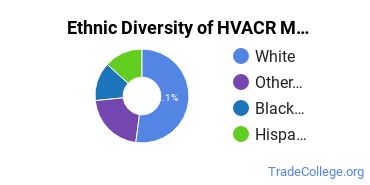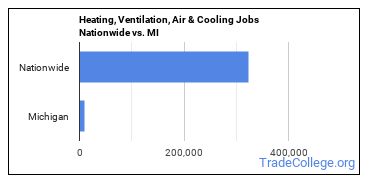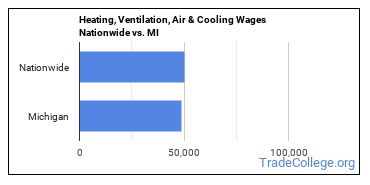Heating, Ventilation, Air & Cooling Schools in Michigan
In 2021-2022, 412 students earned their HVACR degrees in MI.
A Heating, Ventilation, Air & Cooling major is the 16th most popular major in this state.
Featured schools near , edit
Education Levels of Heating, Ventilation, Air & Cooling Majors in Michigan
HVACR majors in the state tend to have the following degree levels:
| Education Level | Number of Grads |
|---|---|
| Award Taking 1 to 2 Years | 305 |
| Award Taking 2 to 4 Years | 305 |
| Award Taking Less Than 1 Year | 64 |
| Associate Degree | 43 |
Gender Distribution
In Michigan, a hvacr major is more popular with men than with women.

Racial Distribution
The racial distribution of hvacr majors in Michigan is as follows:
- Asian: 1.5%
- Black or African American: 18.2%
- Hispanic or Latino: 18.2%
- White: 49.3%
- Non-Resident Alien: 0.0%
- Other Races: 12.9%

Jobs for Heating, Ventilation, Air & Cooling Grads in Michigan
There are 9,100 people in the state and 324,310 people in the nation working in hvacr jobs.

Wages for Heating, Ventilation, Air & Cooling Jobs in Michigan
A typical salary for a hvacr grad in the state is $49,030, compared to a typical salary of $50,160 nationwide.

Most Popular Heating, Ventilation, Air & Cooling Programs in MI
There are 10 colleges in Michigan that offer hvacr degrees. Learn about the most popular 10 below:
Seeking financial aid? At this school, 86% of students receive it. In their early career, MIAT College of Technology grads earn an average salary of $48,954. The student loan default rate is 1.90% which is lower than average.
96% of students are awarded financial aid at this school. Graduates earn an average $29,945 after graduation. The student loan default rate of 4.80% is a good sign that graduates can afford their loan payments.
Seeking financial aid? At this school, 91% of students receive it. This school boasts a lower than average student loan default rate of 4.40%. Graduates earn an average $22,311 after graduation.
Roughly six years after entering college, graduates of this school earn $32,411 a year. Students who attend this public school pay an average net price of $8,940. The 2.70% student loan default rate is lower than average.
The student loan default rate of 3.00% is a good sign that graduates can afford their loan payments. Of all the teachers who work at the school, 27% are considered full time. Grads earn an average early-career salary of $32,680 after earning their degree at this institution.
This school boasts a lower than average student loan default rate of 4.40%. Roughly six years after entering college, graduates of this school earn $22,311 a year. 84% of students are awarded financial aid at this school.
The 2.40% student loan default rate is lower than average. 68% of students are awarded financial aid at this school. A typical student attending LCC will pay a net price of $4,844.
The student loan default rate is 4.10% which is lower than average. The full-time teacher rate is 63%. Roughly six years after entering college, graduates of this school earn $29,224 a year.
This public school has an average net price of $16,583. The student loan default rate is 1.80% which is lower than average. The average student takes 4.52 years to complete their degree at Northern Michigan University.
This private institution charges an average net price of $2,846. Roughly six years after entering college, graduates of this school earn $18,790 a year. 10 to 1 is the student to faculty ratio.
Heating, Ventilation, Air & Cooling Careers in MI
Some of the careers hvacr majors go into include:
| Job Title | MI Job Growth | MI Median Salary |
|---|---|---|
| Heating, Air Conditioning, and Refrigeration Mechanics and Installers | 14% | $46,830 |
Related Majors in Michigan
Below are some popular majors in the state that are similar to hvacr.
| Major | Annual Graduates in MI |
|---|---|
| Vehicle Maintenance & Repair | 727 |
| Heavy Equipment Maintenance | 263 |
| Electronics Maintenance & Repair | 106 |
| Mechanics & Repairers | 41 |
| Precision Systems Maintenance | 5 |
| Other Mechanic Technologies | 1 |
View all majors related to Heating, Ventilation, Air & Cooling
Explore Major by State
Alabama
Arkansas
Connecticut
Florida
Idaho
Iowa
Louisiana
Massachusetts
Mississippi
Nebraska
New Jersey
North Carolina
Oklahoma
Rhode Island
Tennessee
Vermont
West Virginia
View Nationwide Heating, Ventilation, Air & Cooling Report
References
More about our data sources and methodologies.
Featured Schools
 Request Info
Request Info
|
Southern New Hampshire University You have goals. Southern New Hampshire University can help you get there. Whether you need a bachelor's degree to get into a career or want a master's degree to move up in your current career, SNHU has an online program for you. Find your degree from over 200 online programs. Learn More > |

